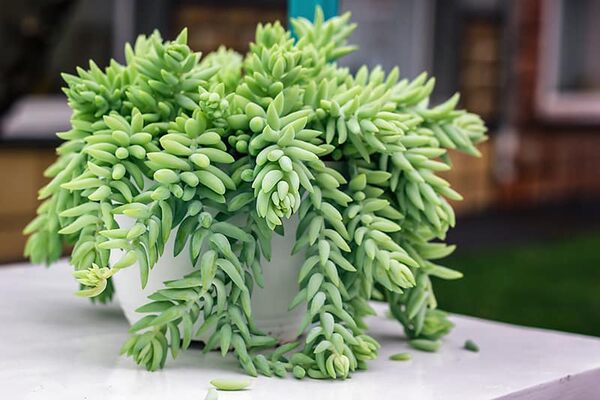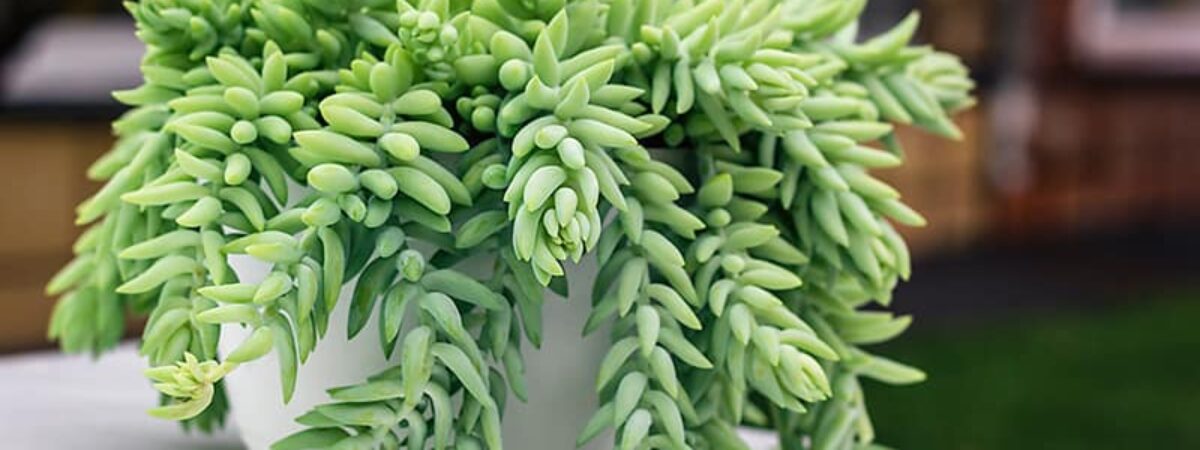Are you among the succulent newbie who wants to grow any succulent that can enrich the beauty of your garden?
Then why don’t you try donkey’s tail succulent?
Donkey’s tail is a gorgeous, beautiful, and tropical succulent is known for its distinctive trailing stems and plump blue-green leaves.
If you want to learn more about this trailing succulent and growing guide of it, then let’s dive into the article below.
Plant Overview

Burro’s tail commonly named the donkey’s tail or scientifically named sedum morganianum, is one of the most popular and adorable potted succulents to take on the houseplant world.
A donkey’s tail is a trailing succulent native to southern Mexico and can be easily found in plant shops or nurseries in its juvenile stage in a four-inch planter’s pot.
Once the plant is mature, it will showcase with big, long stems that drape over the sides of its container. It is one of the most perfect plants for hanging pots in your drawing room or for that high-up spot on your bookshelf.
As beautiful as it is, the donkey’s tail has a reputation for being the most difficult to grow indoors. Each trailing stem of this plant is covered in some small succulent leaves, which make the plant more attractive.
However, you may need to take proper care of these succulents as the slightest brush against them can send all those baby leaves flying onto the ground. This is one of the main reasons that it isn’t the best fit for beginner plant parents.
Varieties of donkey’s tail
There are a lot of varieties of donkey’s tail. However, the two most important and closely related forms of this plant.
Sedum morganianum
This species is commonly named “donkey’s tail”, and this plant can easily be identified by its notably pointed leaves.
S. morganianum ‘Burrito’
This variety is the only named cultivar sold, and is usually marketed under the name “burro’s tail.” This plant can be easily identified by its more rounded leaves. Other than these two species plants are identical.
How to take care of Donkey’s tail?
A donkey’s tail is very easy to take care of and requires less maintenance. However, you may need to treat your donkey’s tail with care while handling it. The eye-catching pointed leaves covering and draping the stems of this plant are extremely fragile and can break off with even the slightest touch.
Temperature
Interestingly, donkey’s tail can stay healthier and grow rapidly when outdoors all-year-round in tropical climates. However, the areas with freezing temperatures during winter require this plant to be indoors.
During winter, make sure to place your plant where the temperature is between 50-60 degrees Fahrenheit. However, room temperature is also fine for these succulents during summers.
water
Unlike other succulents, a donkey’s tail requires a considerable amount of water to keep the leaves attractive and plump. While watering, make sure the soak the water thoroughly and do not water it again until the top of the soil dries out completely, especially when these succulents are kept indoors because it flourishes in tawell-drained container.
If you want to measure it accurately, stick your finger in the water and make sure that the water is at least 1-inch deep around your donkey’s tail.
Being a drought-resistant plant, you do not need to overwater your plant, or else your lovely succulent will rot out. However, remember that mature plants require water more frequently; so make sure to check the soil very often. It is also recommended to water your donkey’s tail once every 14 days.
While watering, make sure to give your plant a thorough drink, so that the accumulated salts from fertilizers and water will flow out from your plant pot.
During the growing season especially when the days are warmer like summer, water your donkey’s tail more often, i.e., every nine days. Usually, the donkey’s tail in clay pots dries out quicker. So, make sure that your plant gets enough water in the hot season.
Light
The donkey’s tail loves to grow in the partial sun or bright shade. This trailing succulent love bright light for at least four hours. If this plant gets heavy sunlight, the scorching sun will burn it. So make sure to give your plant morning sunlight for better growth.
Apart from that, keep your hardy plants indoors in a place like a balcony, in a sunny window, or on a patio, where they can receive enough sunlight.
It is recommended to provide your striking donkey’s tail with bright light indoors during spring which will help to promote blooming.
Soil
Like every other succulent, donkey’s tail also requires good drainage soil to grow healthy as it is indispensable that the water should be drained fast to avoid over-absorption to roots.
So it is better and suggested to use a soil mix that does not settle in water for long; instead, it ensures good drainage in your soil while keeping your plant damage-free.
For that, you can also choose a commercial cactus mix of soil. Moreover, you can also make a well-draining soil mixture on your own by combining the equal parts of perlite or pumice and potting soil.
To make your plant grow healthier, cover the container in which you are growing the plant with worm castings, and compost in spring.
Fertilizer
Fertilizer is not essential for captivating succulent. But if you want better growth, you may feed your plant with a diluted solution of fertilizer two times during its growing season.
But it is suggested that you not feed your donkey’s tail fertilizer more than once a month and avoid fertilizing it during winters.
How to repot donkey’s tail?

OLYMPUS DIGITAL CAMERA
Repotting of your donkey’s tail is often required. Great care should be taken during repotting because of their fragile nature.
Don’t repot your plant regularly. Wait for repotting until it’s necessary. The plant doesn’t mind being a bit root bound, so you only need to repot your plant once every few years.
It is recommended to be careful while repotting your plant to avoid losing many of your “tails” and leaves to jostling when replanting.
However, if you want to repot your succulent at any cost, you will find the most success in the warmer months.
Before starting repotting, make sure the soil is completely dry. Then gently remove the plant from its current vessel, knocking away any old soil from the roots of the plant.
Place the succulent in a new pot especially in a shallow clay pot works best and backfill it with soil, making sure to spread,out the roots in the new, larger pot.
Allow your succulent to rest for a week after repotting or before giving it the first watering in its new home.
How to propagate a donkey’s tail?
As we know, donkey’s tail rarely flowers indoors, so propagating by seed isn’t a viable option for propagation.
But, like most succulents, the donkey’s tail is also easy to propagate through its leaves, which is good news for you as you may not need to work hard, as the leaves of the succulent seem to fall off at the slightest touch.
So you can propagate your plant through its leaves.
If you notice your succulent is shedding some of its leaves recently, simply put them aside unless and until the skin has callused over about two to three days.
From there, fill a pot with cacti or succulent soil mixture or prepare your soil as mentioned above. Lay the leaves on top of the soil and make sure they make contact with the medium.
Mist the soil regularly at least once a week and make sure that the soil stays moist but not soggy until you see new growth start to emerge.
Then, it is recommended to reduce watering and treat the new plant as you would treat an established plant. Young plants require more water than mature plants until they’re established. So be careful while watering making sure not to overwater.
Common pests and diseases
The donkey’s tail succulents are not generally susceptible to pests, but if you notice it is experiencing an infestation, it’s likely to be from aphids. Although, your can hosed off aphids can typically from a plant, that is not the best solution for donkey’s tail succulents as they are fragile in nature.
Instead, it is recommended to mist them every few days with diluted organic neem oil until the aphids disappear completely around two to three weeks.
Mealybugs can also be an issue for your succulents. However, it can also be handled with neem oil.
If you are planting donkey’s tail outdoors, slugs and snails also can be a problem. These problems can be best handled by picking them off by hand or setting out baits for them.
The only significant disease problem the plant can express is root rot, which can occur if the plant is overwatered or it is grown in a dense, poorly draining soil.
Conclusion
Reading this far article might have cleared all your queries regarding the growing and caring guide of the donkey’s plant succulent.
Donkey’s plant succulent is a beautiful plant with attractive and trailing stems and leaves that can surely add beauty to your indoor aesthetic.
So plant and grow trailing and capitative succulent in your home and let us know how it is going.
You may also like to read
Propagating Succulents from Leaves: Know the 5 Smart Steps
How to Grow and Care for Lucky Bamboo Plant- A Step by Step Guide







